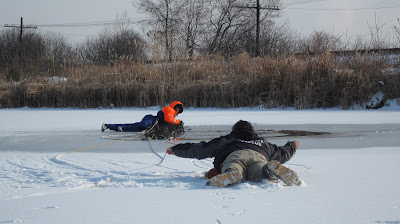Today's goal was to enjoy another summer sunrise and perhaps gain some new sunrise photo opportunities of a re-discovered marsh fifteen minutes from the cottage. It was hard to tear myself away from the view from the dock, though;
But off I went with Tessa, my new back-roading companion who finally, at the ripe old age of nine, seems to have outgrown her car sickness. We arrived at the marsh and were greeted by a nervous family of Wood Ducks, along with a Great Blue Heron, a foraging male American Redstart, noisy Gray Catbirds, singing Swamp Sparrows, and a view to die for:
It was magnificent, and all the more enjoyable today by a lack of mosquitoes that greeted me the last time I was there:
So mission accomplished, I was already pleased with how the day had begun but quickly became angry with myself when it was discovered I had left behind my binoculars at the cottage, so back to the cottage I went to retrieve them. That's when one of those unexpected magical moments occurred, not even a minute from the marsh.
But first let's go back in time to early April, before the leaves were out on the trees, making it easier to spot a massive Porcupine in a tree on one of my favorite roads just minutes from the cottage:
Sadly, most of the time one ever sees Porcupines is as road kill, so to see a live one yes, that sounds weird , in the day time, and with its eyes open was rare, so imagine my surprise two weeks later that I find one again along the same road, perhaps even the same individual? It didn't seem particularly interested in me as we exchanged loving glances with each other through my camera lens:
So fast forward to late-June, it was another wonderful day that took me seven hours (versus the usual one hour) to get home from the cottage when yet again I happened upon this jaw-dropping moment of disbelief along the same back road, in broad daylight.
Twenty seconds of being in absolutely the right place at the right time:
Porcupines don't move very fast, in fact it's almost painful to watch them on the ground as their claws are so incredibly long it must hurt them to walk, or rather waddle! Twenty seconds later it was gone:
So back to this morning at 6:02 a.m.: I'm heading back to the cottage for my binoculars and see this dark shape on the road ahead of me. Now remember it's still early dawn and it's still dark out, and I say to myself "IDIOT, WHY DID YOU LEAVE YOUR BINOS AT HOME?" convince myself that it's a pair of Crows on the road, right? Of course if I had had my binos with me it would have been easy, but nooooo, so I continue on and see this, through my camera lens as I don't have my binos, so it must be a Raccoon:
Or not. It's another Porcupine, what is up with me and Porcupines this year??
So I slowly get out of the car, fully expecting it to take off (as quickly as a waddling Porcupine can do so, that is) but no, it keeps coming straight towards me:
So by now my heart is racing as I figure it's about to head off into the bush here:
But nope.
It keeps coming straight at me, my initial thought between adrenalin rushes was that it was a young one, due to its size and behavior of being unafraid of me, and in fact curious:
I stayed close to the car (with Tessa still inside, no doubt snoozing, a good thing, in hindsight) but it continued to follow me, I could not believe it was happening!
Closer and closer it came! None of these photos are cropped, and at times I had to move away from it as it was too close to focus on:
"Mommy?"
I kept reassuring myself that it was a myth that Porcupines have the ability to throw their quills at their enemies.
Then it raised itself up a bit to check me out:
But all was fine, we both shared a special moment with each other:
By now, a mere six minutes later from my initial sighting of it, there was finally sunlight and golden lighting to boot, and onward it marches!
By now I'm on my knees thanking mother nature for another rare encounter to get at eye level with it, as I knew our time was almost up:
And then it was gone, just like that.
I have had enough wildlife encounters these past few years to recognize that this one today was indeed very rare and special. I kept thinking the whole time it was going to immediately disappear, as that's just what wildlife does, and then the moment would be over, just like my twenty second encounter with the big guy a few weeks ago, but this time it did not, which made it all the more special and memorable for me!
As for Tessa's take on the encounter?






















































